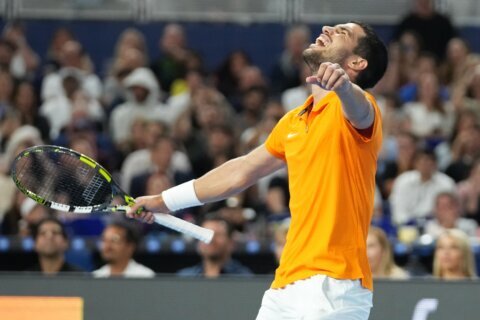WASHINGTON — Would you have known the name of the man in that picture to the right before this week?
Even those who consider themselves to be fans of tennis may not have considered Marin Cilic — or Kei Nishikori, the man he defeated for the U.S. Open Championship on Monday — household names. Both were relative unknowns to the sporting world at large before upsetting Roger Federer and Novak Djokovic, respectively, in the semifinals.
Nishikori’s story was impressive enough. At just 5-foot-10, tiny in today’s tennis world, he became the first Asian-born player to reach a grand slam final. He took out three of the world’s top five seeds , the first time any player had done that in a major since 1982.
But it was Cilic who won an anticlimactic final, 6-3, 6-3, 6-3, locking up his first major championship in under two hours. And while Serena Williams completed a dominate display on the women’s side to capture her 18th major and cement her spot as the world’s top player once again, the question surfaced once again: what is the future of men’s American tennis?
Tennis has faded from the American consciousness over the past years. Wimbledon’s men’s finals ratings were down 10 percent in ratings and 8 percent in viewership from 2013 and 24/28 percent, respectively, from two years ago. Viewership for the U.S. Open’s women’s final was down 18 percent from last year, and almost 50 percent from its golden age, 10-15 years back. We will find out sometime Tuesday how the men’s final stacked up.
CBS carried the U.S. Open from 1968 until Monday, when ESPN took over the reins. The Worldwide Leader is paying $825 million over the next 11 years for the rights to air the Open, certainly not chump change. But more notable is CBS’s decision to drop a tradition of nearly 50 years for NFL football, which will almost certainly do far better in ratings.
Without marketable American stars, men’s tennis has been only partially saved by long-standing rivalries between the Swiss Roger Federer, the Spanish Rafael Nadal, and the Serbian Novak Djokovic. It was the first time since the 2005 Australian Open that none of the three men had appeared in a major final. They had combined to win 34 of the previous 38 Grand Slam trophies.
This is not to say that any of the three are, by any measure, finished. Djokovic is still only 27, and Nadal — somehow — just 28. But at 33, Federer is on the tail end of his prime. They will likely win more majors among them, but at least the armor seems to have been cracked. It may be a sign of the end of their Hydra-like dominance over the rest of the sport.
As for American prospects, John Isner is the highest-rated in the world at 16, but is already 29 years-old. No other U.S. player ranks in the top 45. No American has been the top-ranked player in the world since Andy Roddick in 2003, just before the rise of the Big Three.

College Park, Md. native Francis Tiafoe was the only American to reach the semifinals of the boys junior draw, knocking off current junior world No. 1 Andrey Rublev to do so. Rublev had not dropped a set all tournament before Tiafoe dealt him a 6-1, 5-7, 6-4 defeat in the third round.
The sixth-ranked Tiafoe then lost a heartbreaker in the semis, splitting the first two sets before falling 7-6 (8-6) in a tiebreaker to fifth-ranked Frenchman Quentin Halys. But Tiafoe has impressed on the big stage so far. Last December, he won the Orange Bowl, considered the most prestigious title in the world among juniors. And he doesn’t even turn 17 until next January.
In what is often considered a country club sport, Tiafoe’s is the most American of stories. He is the son of an immigrant from Sierra Leone who was a custodial worker at the Junior Tennis Champions Center. He and his brother Franklin lived with their father on-site and grew up playing around the facilities. Over time, the coaches at the center realized they had a prodigy on their hands.
So while American tennis fans may lament the quiet way in which their national title finished on Monday, the window may be opening to a new era of stars, including one of their own.
Follow @WTOP and @WTOPSports on Twitter and WTOP on Facebook.







